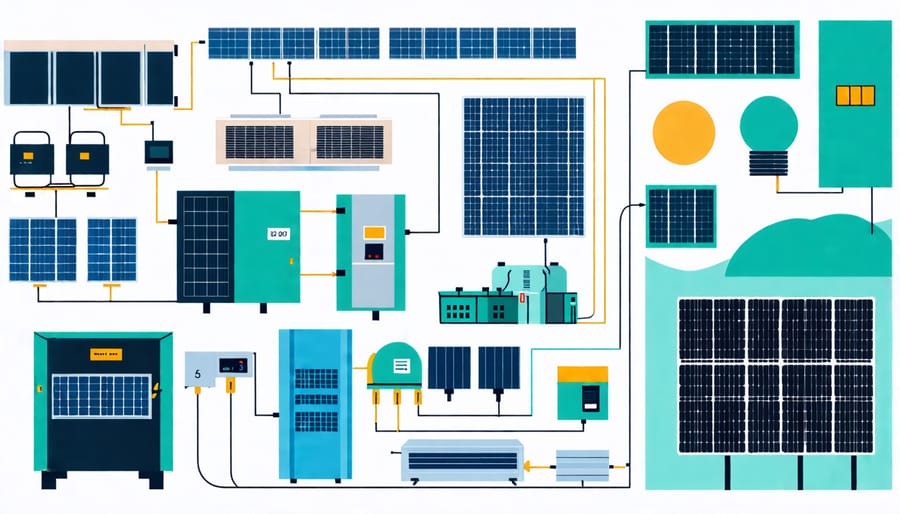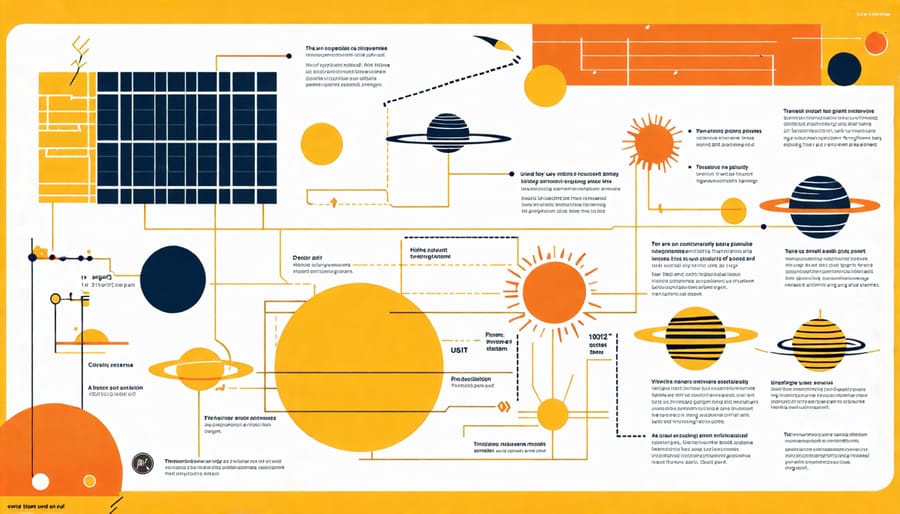Power Up Your Home: Building DIY Hybrid Solar Systems in Europe

Identify the right solar components by focusing on solar panels, inverters, and batteries suited for hybrid systems in European settings. Select high-efficiency monocrystalline panels that perform well in varying weather conditions. Choose inverters that support both grid-connection and battery storage for optimal flexibility. Opt for lithium-ion batteries to ensure long-lasting energy storage with minimal maintenance.
Design your installation layout by evaluating roof space and orientation. Consider using solar trackers to maximize energy capture in regions with less sunshine. Analyze home energy consumption patterns to tailor the system size accurately, ensuring that every kilowatt produced is effectively utilized.
Integrate smart monitoring systems to optimize performance and maintenance. Leverage apps and devices that provide real-time data on energy production and consumption. This allows for proactive adjustments to enhance efficiency and sustainability, essential for European climate variations.
Leverage the expertise and comprehensive project support offered by INOX Solar to streamline the process. Benefit from their innovative solutions designed to enhance efficiency and sustainability, ideal for setting up a DIY hybrid solar system successfully.
The Components of a Hybrid Solar System

Solar Panels and Inverters
Solar panels and inverters play an integral role in any hybrid solar system, bringing together sustainable energy generation and advanced technological efficiency. The role of solar inverters cannot be overstated; they convert the DC electricity generated by solar panels into AC power, which is the standard electricity form used in European homes and industries. Recent advancements in photovoltaic technology have significantly enhanced the durability and efficiency of solar panels, allowing even clouded European skies to yield maximum power output.
In a hybrid system, the synergy between solar panels and inverters ensures not only energy independence but also the capacity to smartly switch between solar and grid power. INOX Solar, a leader in this field, offers state-of-the-art panels that promise high efficiency and longevity. Their sophisticated inverter systems complement the panels by providing seamless energy conversion, reducing wastage and boosting overall system sustainability. Furthermore, INOX Solar supports its European clientele with comprehensive project management, ensuring that every step—from installation to maintenance—is handled with expertise and a commitment to environmental consciousness. This holistic approach not only meets energy needs but also enhances property value across European settings.
Batteries and Storage Solutions
Selecting the right batteries and storage solutions is crucial for any DIY hybrid solar system, especially in Europe’s diverse climates. With advancements in battery innovations, homeowners and businesses can now harness solar energy with enhanced efficiency and reliability. Understanding the types of batteries available can greatly impact your system’s performance and longevity. Lead-acid batteries have been a traditional choice, valued for their affordability and reliability. However, lithium-ion batteries are becoming increasingly popular due to their higher energy density, longer lifespan, and efficiency in charging and discharging cycles.
Durability and capacity are pivotal when considering battery options. Lithium-ion batteries typically offer substantial durability, enduring various European weather extremes—from the cold climates in Scandinavia to the heat of Southern Europe. Additionally, opting for systems that provide customizable storage solutions can maximize your energy management. By configuring your setup to meet specific seasonal demands, you ensure an optimal balance between energy supply and consumption.
Venturing into solar energy should prioritize sustainability and innovation. With comprehensive project support, including expert guidance and tailored solutions, European users can build a robust and efficient hybrid solar system. As you progress in your DIY solar journey, thoughtful selection of batteries and storage solutions is paramount for achieving energy independence and promoting a more sustainable future.
Step-by-Step Guide to Building Your Own System
Planning and Design Considerations
Embarking on a DIY hybrid solar system project requires careful planning and thoughtful design to maximize efficiency and sustainability. Begin with a comprehensive site assessment, evaluating your geographical location, sun exposure, and roofing structure. This step is crucial as European climates can vary widely, affecting solar energy generation potential. Understanding your energy needs is another vital consideration. Conduct a thorough analysis of your household or business’s electricity consumption patterns. This will guide you in determining the appropriate system size, ensuring the hybrid system sufficiently meets your requirements and supports future energy goals.
Adhering to regulatory compliance is a non-negotiable aspect of the planning phase. Each European country has specific regulations concerning solar installations, ranging from building permits to grid connection protocols. It’s essential to familiarize yourself with these regulations, ensuring your system design aligns with local standards and avoids potential legal hurdles. Consulting with local authorities or a solar energy consultant can simplify this process and provide peace of mind.
In addition to these core considerations, exploring innovative technologies and sustainable practices can enhance the overall impact of your solar project. Utilizing energy-efficient appliances and opting for sustainable materials can further elevate the environmental benefits of your solar solution. By approaching the planning and design with a strategic mindset, you can enjoy a highly efficient and compliant hybrid solar system tailored to Europe’s unique energy landscape.


Installation Process
Embarking on a DIY hybrid solar system installation is an exciting journey towards energy independence and environmental sustainability. Begin by ensuring that all components—solar panels, inverters, battery storage, and wiring—adhere to European standards for safety and efficiency. Qualified professionals usually recommend choosing high-quality panels known for their durability and extensive certification across Europe.
Before installation, thoroughly assess the site. Calculate optimal panel angles and positioning to maximize sunlight exposure year-round. Correct panel placement is crucial for efficiency, so use a reliable compass or a solar pathfinder to find the best possible orientation.
The mounting process should start with securely fixing the racking system. Make sure to follow the manufacturer’s instructions, as this is vital for withstanding varied weather conditions. Following this, install the solar panels, ensuring each connection is tight and secure, and verify that the array is wired correctly to the inverter. The inverter should ideally be placed in a shaded area to maintain its efficiency and prolong its life.
Safety is paramount; always turn off electricity at the main switchboard when connecting the system to your home’s power supply. Consider enlisting a certified electrician to handle this crucial step.
Once everything is in place, system testing is essential. Make sure all components communicate effectively and that energy flows efficiently. Lastly, register your system with local authorities, as per European regulations, to benefit from potential incentives. With these steps, your solar installation will be a testament to innovation and efficiency.
Maintenance and Troubleshooting
Maintaining a DIY hybrid solar system is crucial to maximizing its efficiency and prolonging its lifespan. Regular maintenance involves routine inspections of the solar panels for dust, debris, or any shading that might affect solar capture, especially during the less sunny months commonly experienced in various European climates. Cleaning your panels at least once or twice a year with water and a non-abrasive cloth can help maintain their energy absorption capabilities.
It’s also essential to check the wiring and connections for signs of wear or corrosion, especially given Europe’s diverse weather conditions. Ensure that all inverter and battery components are functioning correctly by monitoring the system’s output through your inverter’s software. Doing this will help you quickly pinpoint any discrepancies in energy production.
When it comes to troubleshooting, many common issues such as unexpected shutdowns or reduced power output could stem from inverter malfunctions or battery inefficiencies. Prioritizing the use of batteries designed to withstand European temperatures and climates is key to securing system resilience.
Having a plan for potential repairs is also vital. Partner with local professionals who understand the region-specific needs and challenges. Such cooperation can offer comprehensive support and proactive solutions, enhancing both innovation and sustainability within your solar setup. Remember, a well-maintained hybrid solar system not only supports your energy needs but contributes significantly towards a sustainable future.
Benefits of DIY Hybrid Solar Systems
Adopting DIY hybrid solar systems offers numerous advantages for European homeowners and businesses eager to embrace a more sustainable energy future. One of the most compelling benefits is cost-efficiency. By installing a hybrid solar system yourself, you can significantly reduce labor expenses, making solar energy more accessible. Furthermore, hybrid systems allow you to utilize both solar panels and storage batteries, maximizing energy use and minimizing reliance on the grid. This efficiency translates into notable savings on energy bills, helping to recover the initial investment faster.
In addition to economic advantages, DIY hybrid solar systems allow you to take a substantial step towards reducing your carbon footprint. As Europe intensifies its focus on green energy transitions, these systems provide an opportunity to minimize environmental impact by increasing the use of renewable energy sources. By generating clean electricity and storing excess for later use, hybrid systems reduce dependence on fossil fuels, supporting EU targets for reducing greenhouse gas emissions.
Additionally, these systems substantially enhance energy resilience, a crucial feature in today’s unpredictable energy climate. Hybrid systems supply uninterrupted power even during grid outages, safeguarding homes and businesses from energy disruptions. This resilience is particularly beneficial for businesses that require a constant power supply to protect sensitive data and operations.
Incorporating a DIY approach further empowers individuals and businesses to learn more about energy solutions and sustainability. It fosters a proactive attitude towards innovation, encouraging more personalized, efficient energy setups tailored to specific needs. European users benefit from comprehensive support systems, ensuring that they can undertake projects with confidence and ease. By embracing DIY hybrid solar systems, you’re not just adopting new technology; you’re driving a movement towards a more sustainable, self-reliant future.
INOX Solar: Supporting Your Solar Journey
INOX Solar is committed to supporting your solar journey by providing a comprehensive range of services tailored to suit DIY enthusiasts across Europe. From initial research and development to expert project management, INOX Solar ensures a seamless experience, empowering you to embark on your solar energy projects with confidence. Our commitment to innovation and sustainable manufacturing positions us at the forefront of the green energy movement in Europe.
Understanding the intricacies of hybrid solar systems can be daunting, but our team simplifies the process by offering clear, step-by-step guidance on selecting the right components. Whether you are a homeowner or represent a business or industrial entity, INOX Solar’s bespoke support ensures that your specific needs are met while maximizing system efficiency and sustainability.
As pioneers of solar innovation, we pride ourselves on driving the transformation towards sustainable energy solutions, tailored for the unique European landscape. With INOX Solar, you don’t just choose a service provider; you partner with a leader dedicated to making sustainable energy accessible and beneficial for all, harnessing the power of the sun with precision and care.
Conclusion
Embracing DIY hybrid solar systems represents a significant step towards energy efficiency and independence for European homeowners, businesses, and industries. By integrating this innovative technology, not only can Europeans contribute to a more sustainable future, but they also gain greater control over their energy consumption. These systems offer a customizable solution that can adapt to diverse energy needs, ensuring long-term cost savings and a reduced carbon footprint. With abundant resources and support available, including from providers like INOX Solar, undertaking such a project is both feasible and rewarding, marking a meaningful advancement in Europe’s transition to renewable energy.
Leave a Reply